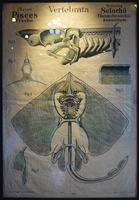Items
Site
The Medicine Chest
keywords is exactly
Julian Jackson
-

'How Zoology was taught in the past'
The wall text accompanying these charts in the Hunterian museum, Glasgow, reads: "In the late 19th and 20th centuries, before the advent of colour slides that could be projected, the teaching of Zoology depended heavily on the use of wall charts to illustrate lectures. They were hung on a special pulley system at the front of the lecture theatre and, because of their large size, could be clearly seen from the back of the class". -

Falling stars
Published in 1841, Jackson’s guide was the first of a series of guides published during this period which offered notes for the traveller on appropriate conduct in the field – from providing methods for training the eye to observe what was deemed as relevant details, to instructions on which precision instruments should be carried and how to use them to record and inscribe the results of observations made (Withers 2013: 170). As Jackson states, his guide pointed out to the “uninitiated Traveller what he [sic] should observe, and to remind the one who is well informed, of many objects which (…) might escape him” (Jackson 1841: i). -

Deductions from smooth rocks
Extract from Bettie Higgs's reading of rocks in 'Visual Practices Across the University'. Most of the rocks in this photograph are about 360 million years old, so the grains that comprise them are substantially older. The grains came originally from a mountain range, as large as the Himalayas, whose roots can still be seen in counties Mayo and Donegal, in the northwest of Ireland. The grains were carried south by rivers and deposited in this area; the smallest grains were carried all the way to the ocean, which was far south of Cork at the time, in what is now the Atlantic Ocean south of Ireland. (There was very little rainfall at the time: the portion of land that is now Cork was 10° south of the Equator. This can be deduced from the properties of the iron in the rock.) The water in which the grains were transported was oxygenated, and the iron precipitated out as iron oxide (haematite), which cemented the grains and which accounts for the red color (Elkins 2007: 74 - 78). -

End papers of 'What to Observe'
Published in 1841, Jackson’s guide was the first of a series of guides published during this period which offered notes for the traveller on appropriate conduct in the field – from providing methods for training the eye to observe what was deemed as relevant details, to instructions on which precision instruments should be carried and how to use them to record and inscribe the results of observations made (Withers 2013: 170). As Jackson states, his guide pointed out to the “uninitiated Traveller what he [sic] should observe, and to remind the one who is well informed, of many objects which (…) might escape him” (Jackson 1841: i). -

Aurora Borealis
Extract from 'What to Observe', 1841, written by Julian Jackson (The Royal Geographical Society) -

Scientific atlases
"Used from the 18th to the 20th centuries, the scientific atlases provided, for example, simplified, generalised and idealised versions of the objects of anatomy, physiology, botany, palaeontology and astronomy, to name a few, guiding the student and practitioner to what was worth looking at, how it looked and, perhaps most important of all, how it should be looked at (Daston & Galison 2007:23). The establishment and representations of these working sets of objects, and the standardised procedures for studying them, thus extended the initial influence exercised on the individual traveller in the field. By controlling the very act of seeing and by creating a sense of individuals working as members of academic communities, the atlases shaped the subjects and the objects of their disciplines. Processes initiated in the field and reinforced in institutions, societies and museums laid the foundation for procedures still used by the disciplinary insiders of university departments today" (Liebenberg 2021: 111).


